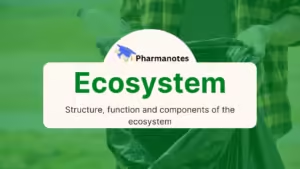Ecosystem

Intended Learning Outcomes
At the end of this Lecture, students will be able to
• Explain Ecology
• Discuss the structure and function of the ecosystem
• Elaborate components of ecosystem
Ecology
• Definition:- Ecology is derived from two Greek words “Oikos” & “Logos”
• Ecology= Oikos + Logos
• Oikos means house or dwelling place
• Logos means the study of
Thus Ecology can be defined as the “Study of organisms to their house or dwelling place”.
Terminology Used in Ecology
• Species: A Uniform interbreeding population spreading over time & space is known as species.
• Community: A group of similar or dis-similar species species living to gather under more or less similar environmental conditions.
• Population: It is a group of similar communities living together under similar environmental conditions.
• Biome: The complex of several types of communities, at different stages of succession living to gather under similar environmental conditions.
• Vegetation: A collective growth of plants in space is known as vegetation.
• Habitat: The place where an organism lives or the place where one would go to find a particular organism is known as habitat.
• Factor: Any external force, substance, or condition that affects the organism in any way is known as a factor.
• Standing state: The total amount of inorganic substances i.e. minerals Such as phosphorous, sulfur, nitrogen, hydrogen, etc. present at any given time in the environment of an ecosystem is known as the standing state.
• Biomass: Biomass is the total amount of living material present in terms of weight/ unit area.
Classification of Ecology
• Ecology can be classified based on its subdivisions as:
• In the early days of Ecology, botanists and zoologists engaged themselves in the study of the ecology of plants & animals respectively this led to the development of such sub-divisions as
a) Plant Ecology
b) Animal Ecology
Based on Habitat Ecology: Some ecologist thought of the study of habitats and their effect on the organisms. They selected many different habitats such as freshwater, grassland, forest, etc. These are then studied in detail for their possible relationship with the kind of organisms present there such an approach led to the development of habitat ecology.
• Based on the level of Organization:- In this approach the organisms involved in ecology are either studied individually or in groups accordingly they are classified as
1. Autecology
2. Synecology:
• Autecology: It is also known as the ecology of individual organisms.
• Synecology: It is also known as the ecology of groups of organisms.
Structure of Ecosystem
The structure of an Ecosystem comprises of:
• The Composition of the biological community including, species number, biomass, life history, and distribution in space.
• The quantity and distribution of non-living material, such as nutrient water, etc.
• The range of conditions for existence such as temperature, light etc.
Function of Ecosystem
The function of the Ecosystem includes:
• The rate of biological energy flow i.e. production & respiration rates of the community.
• The rate of material or nutrient cycles
• Biological or ecological regulation including both regulation of organisms by environment and regulation of environment by the organisms
Components of an Ecosystem
• Each organism has two main components
1. Abiotic
2. Biotic
• Abiotic Component: The non-living factor or the physical environment prevailing in an ecosystem forms the abiotic components.
• Abiotic components are mainly of two types,
(a) Climatic factors include rain, temperature, light, wind, humidity, etc.
(b) Edaphic factors (i.e. factors related to soil): It includes soil, pH, topography, and minerals.
• Biotic Components: The living organisms include, plants, animals, and micro-organisms in an ecosystem from biotic components.
• Biotic Components are further classified into 3 main groups
1. Producers
2. Consumers
3. Decomposers or Reducers
Producer: The green plants have chlorophyll with the help of which they trap solar energy and change it into chemical energy of carbohydrates using simple inorganic compounds namely, water and carbon dioxide. This process is known as photosynthesis.
• The chemical energy stored by the producers is utilized partly by the producers for their growth and survival and the remaining is stored in the plants for their future use.
• Consumers: The animals lack chlorophyll and are unable to synthesize their food therefore they depend on the producers for their food.
• They are known as heterotrophs (i.e. heteros= others, trophs= feeder)
• The Consumers are of 4 types:
(a) Primary Consumer: (Herbivores) i.e. Animal feeding on plants, e.g. Rabbit, deer, goat etc.
(b) Secondary Consumers: The animals feeding on Herbivores are called secondary consumers or primary carnivores. e.g. Cats, foxes, snakes.
(c) Tertiary Consumers: These are large carnivores that feed on secondary consumers. e.g. Wolves
(d) Quaternary Consumers: They are also called omnivores these are the largest carnivores that feed on tertiary consumers and are not eaten up by any other animals. e.g. lion and Tiger.
Decomposers: Bacteria & fungi belong to this category.
• They break down the dead organic matter of producers & consumers for their food and release to the environment the simple inorganic and organic substance. These simple substances are reused by the producers resulting in a cyclic exchange of material between biotic & abiotic environments.
Summary
• Ecology can be defined as the Study of organisms for their house or dwelling place
• Ecology can be classified:
a) Plant Ecology
b) Animal Ecology
• Based on level of Organization:
a) Autecology
b) Synecology
Also, Visit:
B. Pharma Notes | B. Pharma Notes | Study material Bachelor of Pharmacy pdf